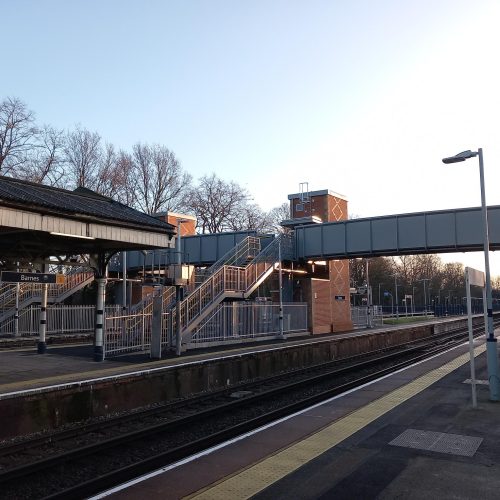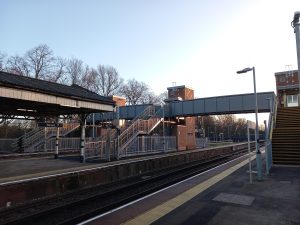
Octavius completed the project to make Barnes Station accessible to all users in 2025. The work followed the proven Access for All (AfA) formula of providing two footbridges, three lifts and three staircases. As with all AfA projects successful delivery was about ensuring this established solution could be made suitable for station-specific circumstances, while addressing the needs of multiple influential stakeholders.
Barnes Station is located in southwest London commuter belt and served by train operating company South Western Railway. Octavius was awarded the AfA project through client Network Rail’s One Team Wessex Framework.
Limited Access
Track access was a significant challenge while making Barnes an accessible for all station. Busy with commuters by day the line through Barnes is extensively used for freight throughout the night. This confined many activities to the weekend, the only time possession could be granted, a factor that constrained the scheduling of the entire project. Track access further shaped the schedule in that work on the island platform could only be undertaken during the night.
Limited access also dictated that everything required for a forthcoming week’s activities had to be brought to site and craned into the compound during the weekend, meaning planning had to be very detailed to ensure everything required was present, and nothing superfluous was taking-up valuable space in the compound.
Preserving Amenity
The station is bounded on most sides by Barnes Common a valuable community resource in a busy suburban area. Powering the AfA’s new lifts required a distribution network operator upgrade, which entailed burying a 200-metre cable beneath part of the common. Sympathetic delivery and reinstatement was vital to preserve the common as an amenity for local people.
Although the common is green space, road access and space adjacent to the station is still restricted. This made the sympathetic attitude of those responsible for the common towards the project a great asset. An area of the common, formerly a railway coal and goods yard, was made available for the compound. The team repaid this support by participating in a volunteering day to help maintain the common.
Another good neighbour was the WWT’s London Wetlands Centre, which allowed the centre’s large entrance area to be used as a turning area for steel deliveries. This support too was repaid by joining one of the centre’s volunteering days.
Aesthetics were another area in which the project needed to integrate with the station’s surroundings. Built in 1856, Barnes’ original structures are Grade II listed. As a result the new lift shafts replicated the brick bond and patterns of the original station buildings in a measure to make the new AfA infrastructure more sympathetic with the original appearance of the station.
Buried Infrastructure
Enabling the excavations for the lift structures required the diversion of 20 signalling and telecom cables and in addition, a fibre optics cable carrying data for financial institutions and government departments. Problems with this critical activity would have had repercussions way beyond the rail network. Although the buried services were more extensive and important than originally believed, the diversions were completed successfully, with minimal impact upon the schedule and no impact on those relying on the cabling for uninterrupted data traffic.
Barnes is one of a quartet of recent AfA projects in suburban west and southwestern London; the others being Isleworth, Stoneleigh and Motspur. They are part of a national portfolio of more than 35 successfully completed AfA projects, making Octavius, probably, the UK’s most experienced AfA delivery partner.
For more information you can contact afa@octavius.co.uk
